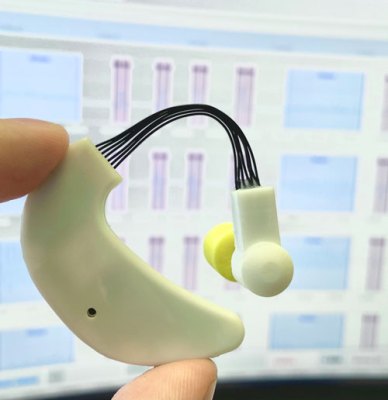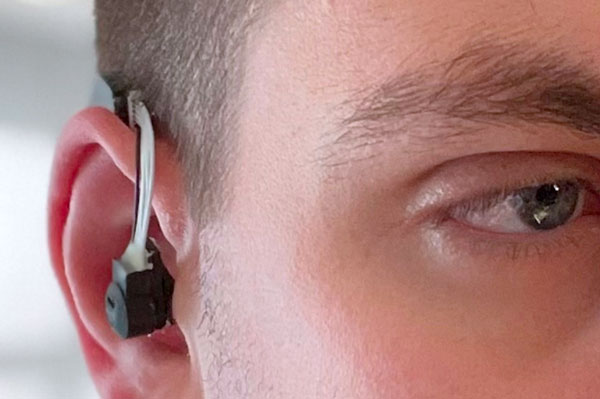All sorts of exciting things happen in your ears, and now there is a good open source way to monitor them. Open Earable is a new project from a group of researchers and companies that monitors and records what is going on in your ear.

The project is designed as an easy-to-build, cheap way for audiologists and others to capture data about what is happening inside and around the ear. It’s a clip-on device that looks like a small hearing aid but has a six-degree Inertial Measurement Unit (IMU) and several other sensors to measure things around your ear and inside the ear canal. A pressure and temperature sensor measures the air pressure and temperature just inside the ear canal, and a small speaker can squirt sound right in there.
A button on the outside allows the user to control the device, and it can play back or record sound to the internal SD card memory. These are all controlled by an Arduino that includes Bluetooth Low Energy. The existing design only allows you to play a stored WAV file, not streaming audio. That’s a solvable problem, though, so it could also be turned into a set of hacker headphones.
Joking aside, this looks like an exciting research project and a useful tool for researchers. The GitHub repository for version 1.3 of the project lays it all out, including a full BoM and code, and the STL files for the case and PCB designs are in the Resources section of the site.
[Updated 18/10/2023 to correct IMU to Measurement, not Management. Intertial management needs a different set of devices]
















This project is really nice! That being said is it just me or do they forget to show actual application for it? I’ve searched on their official website and their github to no avail
https://open-earable.teco.edu/OpenEarable.pdf – Apparently this has 3 example applications (Motion tracking, Ear Canal Pressure, Ear Canal Sound Reflections) but I still don’t get why
Taken from the abstract at your link:
“Based on three exemplar applications from the research literature
we highlight how the platform has to the potential to be used for
motion-based activity tracking, detection of chewing events, and
ear canal shape based authentication.”
I study swordfighting as a hobby. Sometimes I get hit in the head with things.
This could probably be used to measure the potential damage done in sports, such as saber (hit in the head), broadsword, SCA-style rattan swords, or shalaeger blades. Or Boken or Katanas.
Also impact assessment for football and soccer (head-butting the ball), possibly rugby and other sports.
Possibly as continuous monitoring for relatively dangerous jobs such as mining or forestry (got hit on the head by a falling rock/branch, how bad is it?).
It’s got a microphone and speaker, so possibly it’s a platform for hackers to develop bespoke hearing aid configurations (although the arduino is a bit underpowered for that, maybe it could be replaced with a more powerful processor).
It uses a NINA B306-00B (https://www.u-blox.com/en/product/nina-b30-series-open-cpu-0) which contains a nRF52840 SoC. (https://www.nordicsemi.com/products/nrf52840) That’s got a 64MHz processor with 1MB RAM. That ought to be able to handle the audio processing for a hearing aid.
There are existing commercial systems to track head impacts. Either single impact detection or live in progress measurement and reporting impacts.
Single use, like package damage detection https://www.tozuda.com/
Real time monitoring from the sidelines https://content.riddell.com/insite/
I think the project is more designed for data collection rather than a specific application. A lot of audiological research these days is focussed on the way that sound reflects within the ear, so this can capture the reflections when you squirt a specific sound in there. The ultrasonic microphone that they use can measure the dimensions of the ear canal, as well as the way it changes shape with specific sounds using an ultrasonic signal that you can’t hear. That change can also be used to detect jaw and facial movements. It is clever stuff.
https://en.wikipedia.org/wiki/Inertial_measurement_unit
Thanks for the catch: updated.
We’ll solve the mystery of why earworms get stuck in there.
And the results will be good everywhere. It’s a small world, after all.
When I swallow, or clear my ears (on command) both ears click. I guess it’s the ear equivalent of cracking knuckles. One time my girlfriend was laying close .. we were ear to ear. We were both startled to learn that she would hear my ear clicks. I just assumed they were in my head.. as it were. Sounds like this is the prefect tool to record the phenomena, although it’s hard to say for what purpose..
And the results will be good everywhere. It’s a small world, after all.
Check out Otoacoustic Emissions (OAEs) – They are used globally for checking for ‘normal’ cochlear function. A particularly fabulous application is in newborn hearing screening. This can be done within hours of birth, before the child leaves hospital. This platform could well be capable of this. To measure a quiet sound (broadband click or pure tones) is played into the ear canal. A microphone picks up the response. It’s not just an echo of what went in – It’s a distinct response from the cochlea’s reaction to the sound. Some simple DSP (pretty much noise reduction by averaging, correlation and FFT) is carried out.
https://www.nhs.uk/conditions/baby/newborn-screening/hearing-test/
https://www.asha.org/public/hearing/otoacoustic-emissions/
I hear France is making a law so that the government can also ‘listen to see what’s going into your ears’
By allowing the authorities to hack your phone’s microphone and GPS and such.
And in Germany the spooks are already allowed to do that.
(What a wonderful free world we live in eh.)
Anyway, any counter hacks can be sent to HaD submissions- I presume.
Can you provide a link showing both of those things are true about France and Germany?
quick search results:
https://www.lemonde.fr/en/france/article/2023/07/06/france-set-to-allow-police-to-spy-through-phones_6044269_7.html
and
https://www.hrw.org/news/2021/06/24/germanys-new-surveillance-laws-raise-privacy-concerns